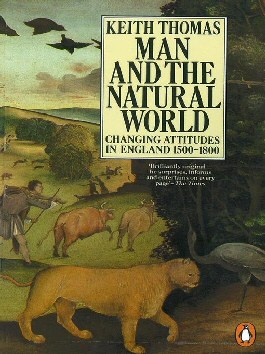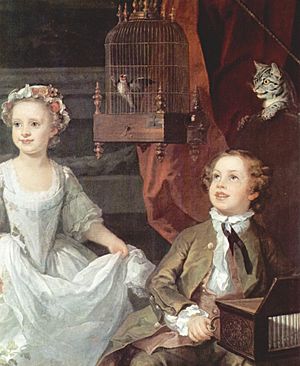Man and the Natural World facts for kids

Man and the Natural World: Changing Attitudes in England 1500–1800 is a book by historian Keith Thomas. It was first published in Great Britain in 1983. The book explores how people in England changed their ideas about nature, animals, and plants between the years 1500 and 1800. It looks at how humans saw themselves in relation to the natural world during this time.
Contents
Humans at the Center of the World
In early modern England, most people believed that humans were the most important beings on Earth. This idea is called an anthropocentric worldview. It meant that everything in nature was thought to be created for the benefit of humans.
Why Humans Were Thought to Be Special
People believed that God made all plants and animals for humans to use. For example, wild animals, birds, and fish were seen as gifts from God. They were meant to be eaten or used by people. Some even thought that farm animals like cows and sheep were only alive to keep their meat fresh until humans needed to eat them!
Even tiny creatures like lice were thought to have a purpose for humans. People believed lice were there to encourage cleanliness. Weeds were seen as a way to make people work hard to remove them. Singing birds were just for human entertainment. This way of thinking meant that no animal or plant was thought to exist for its own sake.
This idea was very strong and few people questioned it. It was only much later that travelers brought back stories of other cultures, like Buddhists and Hindus, who treated animals with more respect. But at the time, most English people found these ideas confusing or even silly. They firmly believed that humans were superior and animals were inferior.
The Human Soul and Animal Machines
One big reason for this human-centered view was the belief that humans had an immortal soul. This meant there was a clear and fixed line between humans and animals. Animals were thought to not have souls.
In the 1630s, a philosopher named René Descartes added to this idea. He suggested that animals were like machines. He believed they could not truly feel pain. This made it easier for people to treat animals however they wanted.
How Science Changed Views on Nature
Over time, the study of nature, called natural history, began to change these old ideas.
Studying Animals and Plants for Themselves
Early ways of classifying animals were based on how useful they were to humans. For example, animals were grouped as "edible" or "useless." This often led to harm for wild animals. Birds like jays, woodpeckers, and wrens, along with squirrels, were often hunted.
However, some animals were treated differently. In parts of England, the robin and swallow were almost sacred. People treated them with respect.
By the 17th century, naturalists (people who study nature) started to look at plants and animals differently. They began to study them just to understand them better. They didn't only care about how useful they were to humans. This was a big step forward.
Pets Bridging the Gap Between Humans and Animals

In the 1500s and 1600s, pets became popular in English homes. People kept them for companionship, especially in towns. Not just dogs and cats, but also pet monkeys, tortoises, otters, rabbits, squirrels, and many songbirds. Popular pet birds included canaries, nightingales, goldfinches, larks, parrots, magpies, and jackdaws.
By the 1700s, people started giving their pets human names. Pets were never eaten. Observing pets helped people see that animals could be intelligent, sensitive, and responsive. They seemed to have many human-like qualities. This helped to break down the idea of a huge, uncrossable gap between humans and animals.
Changing Ideas About Cruelty to Animals
Before 1700, being cruel to animals was very common in England. Activities like bull-baiting (where dogs fought a bull) and cockfighting were popular. Donkeys and horses were often mistreated.
The Rise of Kindness Towards Animals
However, attitudes slowly began to change. Even some religious leaders, like John Calvin, who believed animals were made for humans, said that animals should be treated gently.
From the 1740s onwards, more and more writers, scientists, and poets spoke out against animal cruelty. This movement grew, leading to the creation of the Royal Society for the Prevention of Cruelty to Animals (RSPCA) in 1824. People started to believe that while humans could use animals for food and clothing, causing them unnecessary suffering was wrong.
Some groups, like the Quakers, even stopped hunting for sport completely. In 1789, a thinker named Jeremy Bentham focused on the simple question: "Can animals suffer?" This question changed how many people thought about animal rights.
The Universe and Earth's Age
Astronomers and geologists also played a part in changing how people viewed nature.
Earth Not the Center of Everything
Astronomers discovered that the Earth was not the center of the universe. This made it harder to believe that the entire universe was created just for humans.
Geologists found that the Earth was much, much older than previously thought. They estimated it existed for thousands of years before humans appeared. If the universe and Earth weren't made just for humans, then why would animals and plants be? This question challenged the old human-centered view.
Attitudes Towards Trees and Flowers
People's views on forests and flowers also changed a lot over time.
From Wild Forests to Beautiful Woodlands
At first, forests were seen as wild and dangerous places. They were thought to hide wild animals and outlaws. People believed that early humans lived in forests, and that progress meant moving from the forest to open fields. This led to a lot of forests being cut down. Trees were mainly used for shipbuilding. Between 1500 and 1700, the number of trees in England dropped a lot.
Later, forests began to be seen as "romantic" and beautiful. They added dignity to the landscape. Between 1760 and 1835, private landowners planted about 50 million new timber trees. New and exotic tree species were brought in from other countries.
Flowers for Beauty, Not Just Medicine
Flowers were once grown mostly for their medicinal uses or for their symbolic meanings. But over time, people started growing them simply because they were beautiful. Flowers were imported from all over the world, just for their looks.
Changing Views on Mountains and Nature
Mountains are a great example of how attitudes towards nature changed.
From Ugly to Amazing Mountains
In the mid-1600s, mountains were often hated. They were called "deformities" or "monstrous rubbish" of the Earth. People thought they were useless, unproductive, and dangerous.
Then, religious thinkers started to argue that all of God's creations had a purpose. They said mountains supplied rivers with water and provided homes for goats.
About a century later, mountains became objects of great admiration for their beauty. People forgot that they weren't good for farming. They simply appreciated their grand appearance.
The Idea of Vegetarianism
The arguments against animal cruelty led some people to think even further.
Why Some People Stopped Eating Meat
Once people agreed that farm animals should be treated kindly, it seemed increasingly wrong to kill them for food. The old idea that animals were made just for humans became less popular. Religious arguments for eating meat also became less convincing in a world that was becoming more focused on science and reason.
New arguments for vegetarianism appeared:
- Killing animals was thought to make humans cruel.
- Eating meat was believed to be bad for human health.
- It caused suffering to fellow creatures.
- Raising animals for meat used up more land than growing crops.
Despite these arguments, England did not become a vegetarian nation. Instead, people found ways to hide the origin of meat. For example, pigs, calves, hares, and rabbits were no longer served with their heads attached. Slaughterhouses were also hidden from public view.
Conclusion
The book shows that there was a growing conflict between new, kinder attitudes towards nature and the realities of a society with growing cities and populations. This conflict was never fully solved. The author suggests that modern society still relies on a mix of compromise and hiding the truth about how we treat nature.
Categories

